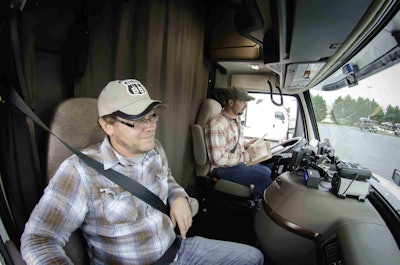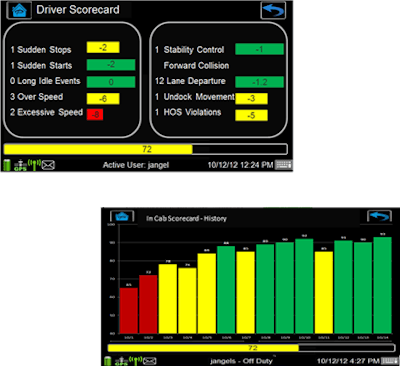
For many carriers, the prolonged driver shortage has led to using new training strategies and technologies to expand their recruiting efforts. Many are now hiring drivers with less experience and higher risk profiles than they previously would have.
In doing so, fleets are facing pressures from within and without to improve their driver risk profiles in short order. Without proof of improvement, plaintiff attorneys may find gaps in a fleet’s hiring and training processes if and when their drivers have accidents.
Michael Holahan, president of FleetQuest in Rochester, New York, has developed a program that fleets can use to develop their drivers and document the improvement process. FleetQuest was formed with a few key business partners and provides sales, marketing and consulting services to the transportation industry.
FleetQuest, he says, has its own proprietary offerings as well as being a value-added reseller of third-party products and services designed to make fleets more competitive and profitable.
Driver development
The new program, called the FleetQuest Fleet Safety Certification, will be compatible with the data from any safety or compliance products that fleets use such as electronic logging devices, telematics, and video-based safety systems that identify driver behaviors, he says.

F. Do not hire
D. Entry-level driver
C. Professional driver
B. Super driver
A. Master driver
Holahan estimates that about two thirds of the drivers that a typical fleet has are “C” or “D” drivers, while about 30 percent of a fleet’s tenured drivers are safe, top-performing “A” or “B” drivers. He says that most “A” or “B” drivers are not looking to change jobs.
“It’s the bottom group of ‘C’ and ‘D’ drivers that are constantly churning and lead to 100-plus percent turnover that all too many fleets are experiencing today,” he says. “Something must be done to shore up driver’s safety and performance or legal liabilities may be more than insurance carriers can bear.”
With the right driver development program, he says fleets should be able to flip the ratio to 70 percent of their current drivers being “A” or “B” within as short a period of time period as one year. Fleets that participate in the FleetQuest program will also be able to produce hard-copy evidence that the drivers they hired have improved their skills by going through a focused and comprehensive development process.
Such evidence is useful when a fleet is questioned by a plaintiff attorney, he says. Suppose an inexperienced driver hired by a fleet is involved in an accident with fatalities. A fleet could prove the driver had moved over time from a “D” to an “A” driver and was in the 92 percentile, for example, in a driver development program that is weighted heavily towards safety.
In addition to providing liability protection, Holahan says the intent for the FleetQuest Fleet Safety Certification program is to be recognized by insurance companies to make carriers “far more insurable” and qualify for lower insurance premiums, deductibles, and self-insured retentions.
Rewarding behaviors
Behavior modification and driver retention are central tenets of the safety certification program. FleetQuest is offering a “Road to Success” rewards platform for its customers to recognize their drivers for doing what they trained them to do.
 FleetQuest plans to use data on driver behaviors from various sources. Shown above is a scorecard developed by PeopleNet.
FleetQuest plans to use data on driver behaviors from various sources. Shown above is a scorecard developed by PeopleNet.FleetQuest customizes the Road to Success platform for clients based on how they evaluate and rank various measures of driver safety and performance. The platform can be used to award points to drivers each month that they can redeem towards a wide variety of goods — merchandise, travel, restaurant coupons — from an online catalog.
“Drivers will always say they want money,” Holahan says, “but behavioral science has shown that the most effective way to change and sustain desired behaviors is to give tangible rewards. Trophy value and family involvement are powerful tools.”
A few examples of reward categories are on-time delivery, fuel mileage, no logbook violations, no preventable accidents and no workers comp claims. To stress safety further the driver can earn points for no sudden accelerations, no sudden deceleration, no hard turns, no tickets for excessive speeding, and safe following distances.
Drivers receive a monthly statement showing the number of points they have earned and year-to-date totals for each reward category. The monthly statement can include personalized messages to drivers from fleet management, he says.
Holahan recommends that fleets budget up to $750 a year in points for each driver with the idea that the driver would actually earn about $500.
“Setting the bar is key,” he says. “Not too high and not too low. Too high and the driver may not even try to improve her behavior; too low and she gets points for what she was already doing.”
For a typical over-the-road carrier, the cost of the points program would equate to cost of about $.004 (four tenths of a cent) in cost per mile for drivers, he says.
A seal of approval
As part of the program, FleetQuest is working to create a Safety Review Officer. This position will be a FleetQuest employee qualified to examine a fleet’s hiring and training processes and to assist with implementation of the driver assessments, Road to Success and other components of the Fleet Safety Certification program.

“If we can do this as an industry, we’ve got something that is powerful,” he says.
Holahan has worked in transportation since 1980. He began as a dispatcher for a small trucking company and held sales positions at Comdata, EFS and Travel Ports of America (acquired by TravelCenters of America).
While chief executive officer of the North American Truckstop Network (NATSN) he served on the board of directors of the Truckload Carriers Association, the Professional Truckdriver Institute, and Trucker Buddy.
For questions or further information Holahan can be reached at [email protected]











